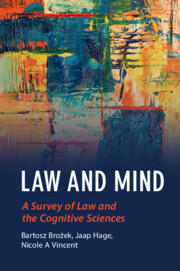Book contents
- Law and Mind
- Law and the Cognitive Sciences
- Law and Mind
- Copyright page
- Contents
- Figures
- Contributors
- Acknowledgements
- 1 Introduction
- I Metatheory and Methodology
- II Ontology and Epistemology
- 6 Cognitive Science and the Nature of Law
- 7 The Architecture of the Legal Mind
- 8 The Psychology of the Trial Judge
- 9 Institutional Design and the Psychology of the Trial Judge
- 10 Bias at the Surface or the Core? A Comment on the Psychology of the Trial Judge
- III Legal Doctrine and Cognitive Sciences
- IV Evidence
- V Dissenting Opinions
- References
9 - Institutional Design and the Psychology of the Trial Judge
from II - Ontology and Epistemology
Published online by Cambridge University Press: 21 April 2021
- Law and Mind
- Law and the Cognitive Sciences
- Law and Mind
- Copyright page
- Contents
- Figures
- Contributors
- Acknowledgements
- 1 Introduction
- I Metatheory and Methodology
- II Ontology and Epistemology
- 6 Cognitive Science and the Nature of Law
- 7 The Architecture of the Legal Mind
- 8 The Psychology of the Trial Judge
- 9 Institutional Design and the Psychology of the Trial Judge
- 10 Bias at the Surface or the Core? A Comment on the Psychology of the Trial Judge
- III Legal Doctrine and Cognitive Sciences
- IV Evidence
- V Dissenting Opinions
- References
Summary
This chapter discusses the ways in which the psychology of judicial decision making may be intertwined with wider institutional design aspects. It is commonly recognized that decision-making processes are susceptible to various cognitive biases, and judicial decisions are no exception. Extending the focus from the individual trial judge to the characteristics of the court in which a judge operates, this chapter’s aim is to highlight the possible role of procedures and institutions in perpetuating, exacerbating or creating cognitive biases in judicial decisions.
These cognitive biases and heuristics are of particular interest as they can not only lead to transient effects on decisions but can also affect judgements in more systematic and prolonged ways. The expertise and repeat experience that characterize judges can lead to the creation of schemas and baselines which judges employ in individual cases. The institutional capacity of the courts and the applicable rules of procedure and evidence can foster different decision-making environments, thereby changing the schemas created and pushing judicial decisions in a particular direction.
This chapter reviews this connection between institutional design and the psychology of judging through three prominent examples. The first section discusses how due to context-dependent decision making, case assignment across courts can change the relative within-docket evaluation of particular cases, thus altering the substantive outcomes reached by the courts. The second section draws attention to the tension between the human tendency to retributivism and the rehabilitative goals set by problem-solving or treatment-oriented courts, and how this tendency may be responsible for some unintended consequences of specialized courts. The third section reviews the accumulating findings regarding the difficulty of disregarding irrelevant or inadmissible evidence, and discusses how these could inform the applicable rules of evidence governing trials.
- Type
- Chapter
- Information
- Law and MindA Survey of Law and the Cognitive Sciences, pp. 193 - 206Publisher: Cambridge University PressPrint publication year: 2021
References
- 1
- Cited by

